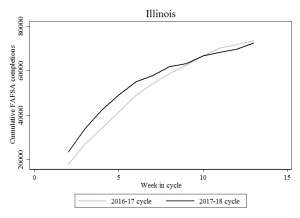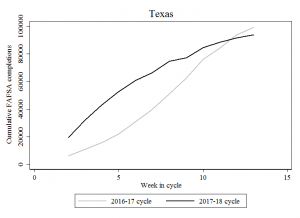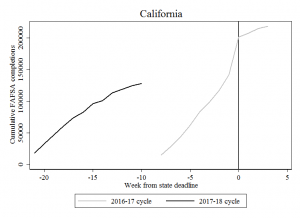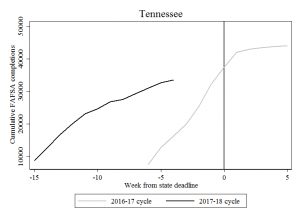There are two ways to track FAFSA completions: week-in-cycle or week-on-calendar. The good folks at the US Department of Education report both, so it’s up to the researcher to decide how best to use this data. Each approach has merits and below are a couple of examples that show why.
The “week-in-cycle” approach seems preferable when states do not have hard filing deadlines. This is because these states use a first-come first-serve approach, where funds are available until they run out. October 1 marked the first day funds were available for the current cycle and January 1 for last cycle. This means “Week 1” is when the state rings the bell to start the financial aid race.
The figure below shows how this plays out in IL and TX. Here we compare last year’s and this year’s cycles and can see nearly identical patterns: there was a nice boost in the first several weeks, but this boost cools down around Weeks 10 or 11. In these states (which have two of the nation’s largest aid programs) we are seeing fewer completed FAFSAs this year:
The “week-on-calendar” approach seems best to use in states that have hard filing deadlines. Missing this deadline means missing out on aid. This matters when comparing trends in the two filing cycles because “Week 13” corresponds with different calendar dates: March 25, 2016, versus December 23, 2017. If I am in a state with a March deadline (as many have) then I want to see how many people have filed relative to that deadline.
California and Tennessee are good examples. California’s deadline is March 2nd and the Tennessee Promise’s deadline is January 17, so let’s set those deadlines at the value of zero below. The weeks on the x-axis tell us how many weeks we are out from the deadline:
California is still several weeks out from its deadline, but Tennessee is only a few weeks away. In both states, FAFSA completions are below last year’s levels, but we should expect a bump in the weeks immediately prior to the deadline. Once those deadlines pass, we should expect to see things flatten out as the states’ main programs targeted to high school seniors close their books for the year.
The next trick is verifying the priority dates and deadlines for each state. The Office of Federal Student Aid provides a database here and NASFAA has one here, which will be handy as we analyze and share this data.



